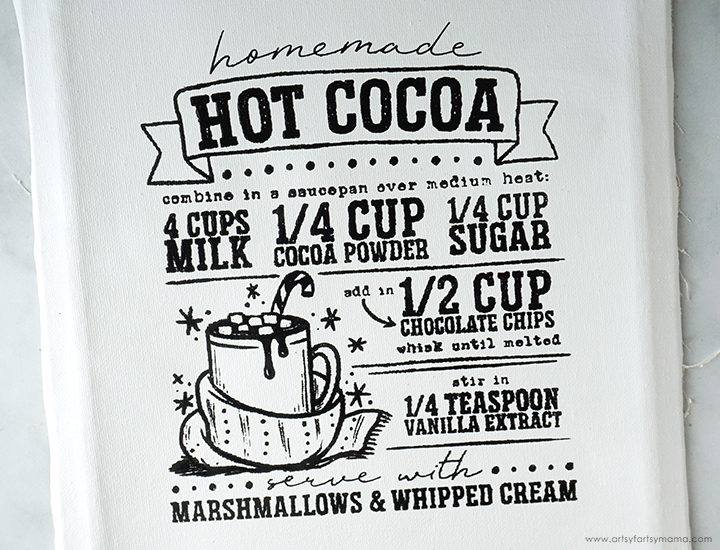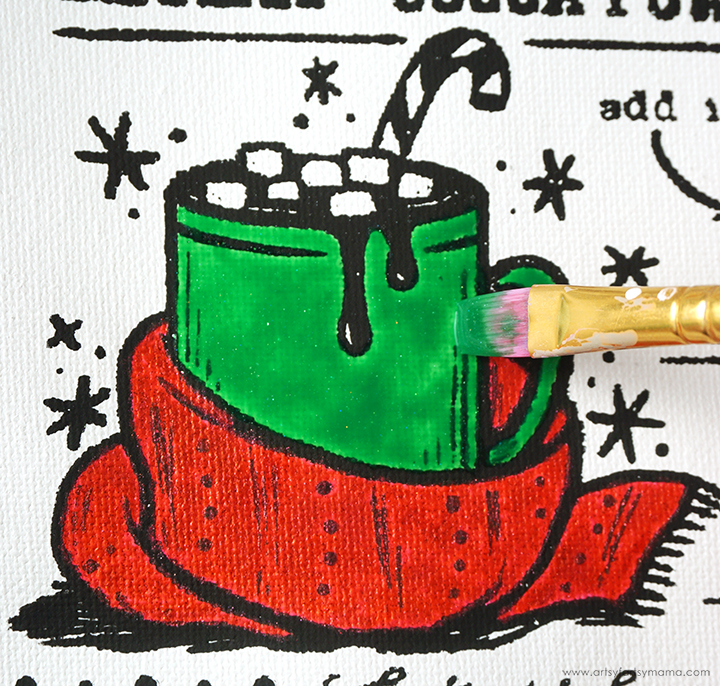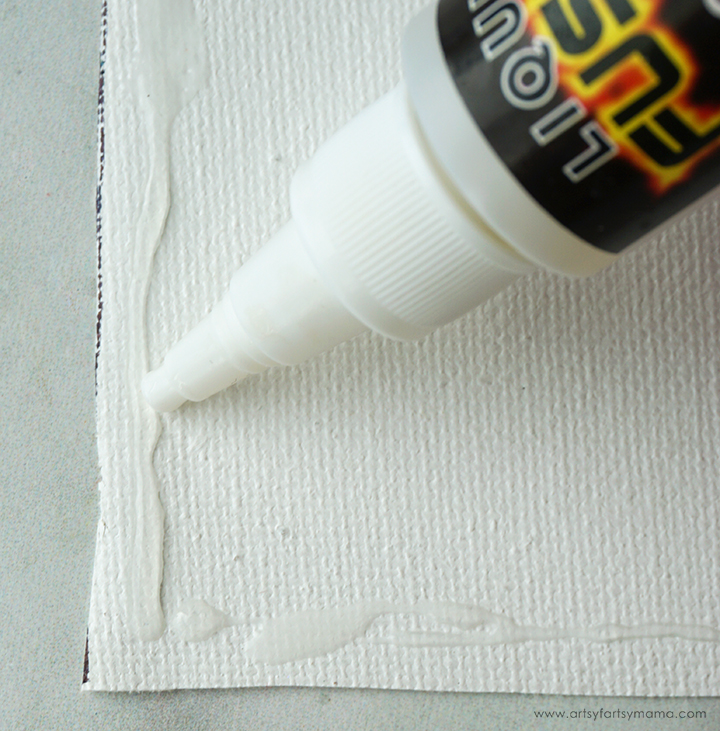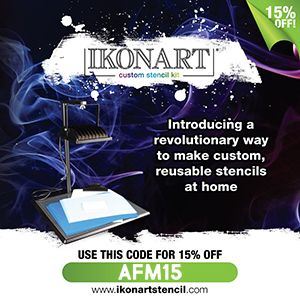Warm up your home with a stenciled Hot Cocoa Reverse Canvas Sign!

One of the best parts of winter is a steaming cup of homemade hot cocoa! Instead of adding it to my recipe book, I decided to create a piece of decor using my favorite cocoa recipe. This Hot Cocoa Reverse Canvas Sign was made using a simple canvas and a custom stencil (thanks to my Ikonart kit). It was such a fun and simple project to make, and I absolutely love how it turned out. Not only am I going to show you how to make this festive holiday decor, but I'm also sharing the FREE design so that you can make one for your own home!!
New to making reusable stencils? Here's how to Get Started with Ikonart!

To make your own Hot Cocoa Reverse Canvas Sign, you will need these supplies:
- Hot Cocoa Recipe Design (for personal use only)
- 9"x12" Canvas
- Craft Knife
- Ikonart Custom Stencil Kit
- Scissors
- Sandpaper
- Chalk Paint or Acrylic Paint - black
- Acrylic Paint or Unicorn Spit Sparkling - red, green
- Squeegee
- Paint Brush
- Detail Brush (optional)
*Save 15% on Ikonart supplies when you shop with code AFM15

To make a stencil, you need to start with a printed design. Download the Hot Cocoa Recipe Design (for personal use only) and print the design as dark as possible on either inkjet or laser Ikonart Printer Film.
The next step in the process is exposing the stencil film. Set up the exposure stand with UV LED Light by following the directions included in the kit. Ikonart Stencil Film is light sensitive, so be careful to keep it out of sunlight and bright lights before exposure. Cut a piece of the film the same size as the design print.
Lay the piece of film down on the base of the stand with the textured side facing up. Place the printed design on top of the stencil film, making sure it's right-side up - meaning that you should be able to read the words printed on the design.
Lastly, place the clear exposure sheet (found in the stencil film pack) on top and press it down well to seal the design tight against the stencil film. Turn the exposure light on and expose the film for 35 seconds.

The final step in the stencil-making process is to washout, or rinse the stencil. Clip the exposed stencil film to the Ikonart clipboard with the shiny side (carrier sheet) touching the clipboard. Use the kitchen sink sprayer to rinse the stencil film with warm water until the design shows through and becomes completely clear. The washout process shouldn't take more than 3 minutes.
Gently blot the excess water from the stencil, and hang or lay the stencil flat to dry for about 45 minutes. When the stencil is dry, you shouldn't see any water spots or discoloration. Once the stencil is completely dried, place the it back on the exposure stand and expose it again for at least 2 minutes without the clear cover sheet. This extra exposure time will increase the durability of the stencil so you can get as much use out of it as possible.

While the stencil is drying, prep the canvas. Turn the canvas over on your workspace. Use a craft knife to carefully cut the canvas just above the staples. This will free the canvas from the wooden frame. Don't worry about removing the staples.
Once the canvas fabric is removed, it's important to smooth out the surface texture. If you don't, you are more likely to have bleeds and missed spots when using the stencil. I rubbed the surface of my canvas with sandpaper to smooth it out and to get rid of a lot of the texture. You could also cover the canvas with a thin layer of Mod Podge.

Sand the canvas frame with sandpaper to make it as smooth as possible. Then cover the frame in any color of acrylic paint. I watered down some brown acrylic paint, and applied a couple of layers so that it looked more like a stain instead of a solid paint layer. Allow the paint to dry completely between layers.

Use a permanent marker and write "back" on the carrier sheet (shiny side) on the back of the stencil. This will help you put the stencil back together the correct way after you are done using it.

Peel the carrier sheet away from the stencil and set it aside (don't throw it away). Carefully rub the stencil down and apply pressure to help it stick to the surface and to get rid of any air bubbles trapped underneath.
Apply a line of acrylic paint* or chalk paint at the top of the stencil (but not too close to the edge). Gently pull the squeegee down over the stencil until the open areas are all evenly covered. Scrape away the excess and put it back onto the paint tray or bottle.
*Because acrylic paint has a thinner consistency, you are likely to have more trouble with bleeds on stencil projects. Chalk paint is thicker than regular acrylic paint, so it helps to create crisp lines when stenciling. To thicken your acrylic paints (any brand or type), I recommend mixing in a little bit of chalk paint powder.
Just add a little bit of powder to the paint and stir it together with a craft stick. Add a little more powder at a time, if necessary, until you get the consistency you want.
If you're not sure what type of paint to use on your project, Ikonart has a list of paint and ink selections to help you out!

Chalk paint is thicker, but it also dries quicker than regular acrylic paint. After covering the top section with paint, lift the stencil up to reveal that part and then gently lay the stencil back down (don't add pressure or anything). This simple step will help to prevent the paint from drying in the mesh and lifting up with your stencil later.
If you lift it up and see any spots that you may have missed, carefully lay the stencil back down and add a little more paint.

Once every part of the stencil has been covered, peel the stencil away. If you notice any missed spots or bleeds, grab a small detail paint brush and add a light coat of paint over the area(s).
Let the paint dry completely, and wash the stencils well following the instructions below.
Washing Stencils:
For best results, wash stencils while the paint is still wet. To wash your stencil so that it can be used again and again, first get the clipboard wet so your stencil doesn't stick to it. Place the stencil on the clipboard with the textured side up, and lightly rub the stencil under cold running water to remove all the paint.
Do not rub or scrub the adhesive side of the stencil, and NEVER use anything other than water to wash the stencils. To prevent the stencil from breaking down, don't ever leave the stencils to soak.
Remove the stencil from the clipboard and lay it down with the adhesive side up. While the stencil is still wet, place the carrier sheet onto the stencil so that the word “BACK” is readable. Hang or lay the stencil flat to dry completely.

After applying the stencil, I felt like it needed a little pop of color. Using a small brush, I colored in the scarf with a thick layer of Unicorn Spit Sparkling. It's kind of perfect for this because it's vibrant, but also a bit transparent. I can't deny that I love the addition of glitter!



Apply a thin line of strong adhesive along all four edges of the canvas. Don't put too much on, or you will have it ooze out and make a giant mess for yourself. A little bit goes a long way!
Place the canvas face down on the back of the frame, and press the edges of the canvas down well. Turn the frame over, and make adjustments as necessary to center the canvas. Hold the canvas in place with your hands, clamps, or even staple it until the adhesive has set.

I absolutely LOVE how this Hot Cocoa Reverse Canvas Sign turned out!! With all of the fine details in the image, I can't (and don't) even want to imagine trying to weed this out of vinyl. What a nightmare!! Ikonart truly made this project so simple. I kind of want to see what other decor I can make with this same design.
I'd love to hear what you think about this project, or if you want to know more about reusable stencils. If you've made your own stenciled projects, I would love to see your creations! Share them on Instagram, Facebook, or leave a comment/photo on the project pin on Pinterest! #AFMCrafts
Don't forget to Pin, Like, and Share!











